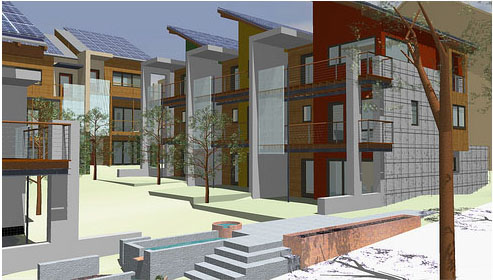Something for Nothing

[ David Vandervort Architects ]
The Issaquah net-zero energy homes project broke ground on Monday, just three months after Howland Homes took over the project from Noland Homes. Check out the project web site for a graphical explanation for how net-zero is hoped to be achieved.
The rendering above shows what appears to be an innovative integration of vertical concrete walls to provide thermal mass. It also shows a whole lot of photovoltaic (PV) panel on the roofs, which is necessary for achieving net-zero energy use, but adds about $35k to the cost of each unit. At a typical Seattle-area electricity cost of 6 cents/kWh, the 5255 kWh per unit generated by the PV is worth about $315 per year. With no incentives and assuming electricity rates don’t go up, that translates to a 111 year payback. Ouch. Of course, that payback would be a lot shorter if we were paying the true cost of that electricity, include all the externalities, but our economic system isn’t that smart.
It will interesting to see if the project can actually achieve net-zero. For one thing, resident behavior will be a big factor — one big-screen plasma TV and it’s game over. As of 2007, only one house in the United States has demonstrated a full 12 months of net-zero energy performance. So far, it seems the zero-energy label has been applied to projects a little too liberally, as with the Zero Energy Idea House, which “opted to forego ‘true’ zero energy.” Even the noted BedZED project in Britain has had operational issues that have precluded the achievement of net-zero.
I don’t mean to come across as a big bad naysayer on this. These projects are models for what we should be shooting for with every new building. But let’s not be deceived about the challenge.
